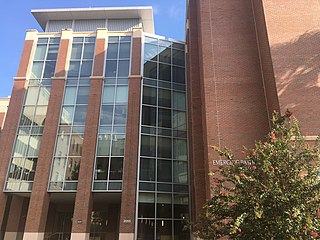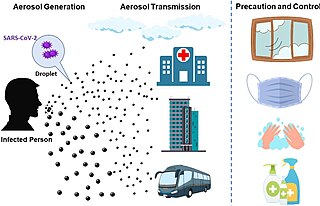Related Research Articles

Severe acute respiratory syndrome–related coronavirus is a species of virus consisting of many known strains phylogenetically related to severe acute respiratory syndrome coronavirus 1 (SARS-CoV-1) that have been shown to possess the capability to infect humans, bats, and certain other mammals. These enveloped, positive-sense single-stranded RNA viruses enter host cells by binding to the angiotensin-converting enzyme 2 (ACE2) receptor. The SARSr-CoV species is a member of the genus Betacoronavirus and of the subgenus Sarbecovirus.

In virology, a spike protein or peplomer protein is a protein that forms a large structure known as a spike or peplomer projecting from the surface of an enveloped virus. The proteins are usually glycoproteins that form dimers or trimers.

The Emerging Pathogens Institute (EPI) is an interdisciplinary research institution associated with the University of Florida. The institute focuses on fusing key disciplines to develop outreach, education and research capabilities designed to preserve the region's health and economy, as well as to prevent or contain new and re-emerging diseases. Researchers within the institute work in more than 30 different countries around the world, with over 250 affiliated faculty members stemming from 11 University of Florida colleges, centers and institutes. The 90,000-square-foot building includes laboratories and collaborative space for bioinformatics and mathematical modeling.

This is a list of several significant scientific events that occurred or were scheduled to occur in 2021.

Severe acute respiratory syndrome coronavirus 2 (SARS‑CoV‑2) is a strain of coronavirus that causes COVID-19, the respiratory illness responsible for the ongoing COVID-19 pandemic. The virus previously had a provisional name, 2019 novel coronavirus (2019-nCoV), and has also been called the human coronavirus 2019. First identified in the city of Wuhan, Hubei, China, the World Health Organization declared the outbreak a public health emergency of international concern on January 30, 2020, and a pandemic on March 11, 2020. SARS‑CoV‑2 is a positive-sense single-stranded RNA virus that is contagious in humans.

The Wuhan Institute of Virology, Chinese Academy of Sciences is a research institute on virology administered by the Chinese Academy of Sciences (CAS), which reports to the State Council of the People's Republic of China. The institute is one of nine independent organisations in the Wuhan Branch of the CAS. Located in Jiangxia District, Wuhan, Hubei, it opened mainland China's first biosafety level 4 (BSL-4) laboratory. The institute has collaborated with the Galveston National Laboratory in the United States, the Centre International de Recherche en Infectiologie in France, and the National Microbiology Laboratory in Canada. The institute has been an active premier research center for the study of coronaviruses.

Coronavirus disease 2019 (COVID-19) is a contagious disease caused by a virus, the severe acute respiratory syndrome coronavirus 2 (SARS-CoV-2). The first known case was identified in Wuhan, China, in December 2019. The disease quickly spread worldwide, resulting in the COVID-19 pandemic.

The transmission of COVID-19 is the passing of coronavirus disease 2019 from person to person. COVID-19 is mainly transmitted when people breathe in air contaminated by droplets/aerosols and small airborne particles containing the virus. Infected people exhale those particles as they breathe, talk, cough, sneeze, or sing. Transmission is more likely the more physically close people are. However, infection can occur over longer distances, particularly indoors.
Bat coronavirus RaTG13 is a SARS-like betacoronavirus that infects the horseshoe bat Rhinolophus affinis. It was discovered in 2013 in bat droppings from a mining cave near the town of Tongguan in Mojiang county in Yunnan, China. In February 2020, it was identified as the closest known relative of SARS-CoV-2, the virus that causes COVID-19, sharing 96.1% nucleotide similarity. However, in 2022, scientists found three closer matches in bats found 530 km south, in Feuang, Laos, designated as BANAL-52, BANAL-103 and BANAL-236.

The COVID-19 Genomics UK Consortium (COG-UK) is a group of public health agencies and academic institutions in the United Kingdom created in April 2020 to collect, sequence and analyse genomes of SARS-CoV-2 as part of COVID-19 pandemic response. The consortium comprises the UK's four public health agencies, National Health Service organisations, academic partners and the Wellcome Sanger Institute. The consortium is known for first identifying the SARS-CoV-2 Alpha variant in November 2020. As of January 2021, 45% of all SARS-CoV-2 sequences uploaded to the GISAID sequencing database originated from COG-UK.
Nextstrain is a collaboration between researchers in Seattle, United States and Basel, Switzerland which provides a collection of open-source tools for visualising the genetics behind the spread of viral outbreaks.

There are several ongoing efforts by scientists, governments, international organisations, and others to determine the origin of SARS-CoV-2, the virus responsible for the COVID-19 pandemic. Most scientists say that as with other pandemics in human history, the virus is likely of zoonotic origin in a natural setting, and ultimately originated from a bat-borne virus. Many other explanations, including several conspiracy theories, have been proposed about the origins of the virus. Some scientists and politicians have speculated that SARS-CoV-2 was accidentally released from a laboratory, but this theory is considered much less likely than a natural origin due to the absence of supporting evidence.

The COVID-19 lab leak theory, or lab leak hypothesis, is the idea that SARS-CoV-2, the virus that caused the COVID-19 pandemic, escaped from a laboratory. Most scientists believe the virus spilled into human populations through natural zoonosis, similar to the SARS-CoV-1 and MERS-CoV outbreaks, and consistent with other pandemics in human history. Available evidence suggests that the SARS-CoV-2 virus was originally harbored by bats, and spread to humans multiple times from infected wild animals at the Huanan Seafood Market in Wuhan in December 2019.
RacCS203 is a bat-derived strain of severe acute respiratory syndrome–related coronavirus collected in acuminate horseshoe bats from sites in Thailand and sequenced by Lin-Fa Wang. It has 91.5% sequence similarity to SARS-CoV-2 and is most related to the RmYN02 strain. Its spike protein is closely related to RmYN02's spike, both highly divergent from SARS-CoV-2's spike.

Emma Hodcroft is a British-American molecular epidemiologist at the Institute for Social and Preventive Medicine at the University of Bern. Her research focuses on the phylogenetics of viruses and other pathogens, mapping the spread and evolution of different genetic variants. Hodcroft is a developer on the Nextstrain project, an open science project that tracks the transmission chains of SARS-CoV-2 and other pathogens. In 2020, she originated CoVariants.org, a project tracking SARS-CoV-2 variants.

Spike (S) glycoprotein is the largest of the four major structural proteins found in coronaviruses. The spike protein assembles into trimers that form large structures, called spikes or peplomers, that project from the surface of the virion. The distinctive appearance of these spikes when visualized using negative stain transmission electron microscopy, "recalling the solar corona", gives the virus family its main name.
ORF10 is an open reading frame (ORF) found in the genome of the SARS-CoV-2 coronavirus. It is 38 codons long. It is not conserved in all Sarbecoviruses. In studies prompted by the COVID-19 pandemic, ORF10 attracted research interest as one of two viral accessory protein genes not conserved between SARS-CoV and SARS-CoV-2 and was initially described as a protein-coding gene likely under positive selection. However, although it is sometimes included in lists of SARS-CoV-2 accessory genes, experimental and bioinformatics evidence suggests ORF10 is likely not a functional protein-coding gene.
Jesse D. Bloom is an American computational virologist and Professor in the Basic Sciences Division, the Public Health Sciences Division, and the Herbold Computational Biology Program, at the Fred Hutchinson Cancer Center. He is also an Investigator of the Howard Hughes Medical Institute, and an Affiliate Professor in the University of Washington departments of Genome Sciences and Microbiology.
Keith R. Jerome is an American virologist whose research focuses on viruses such as herpes simplex, HIV and hepatitis B that persist in their hosts. He published on the first known case of COVID-19 in the United States detecting SARS-CoV-2 in Washington State and helped forge the nation's COVID-19 testing. In 2021, Jerome and Alexander Greninger shared the Washington Innovator of the Year award for developing the laboratory based assay for detecting COVID-19. He was senior author on a research article published in Science describing the cryptic transmission of SARS-CoV-2 alongside Trevor Bedford, Alexander Greninger, Jay Shendure, and Helen Chu. Regarding the origin of SARS-CoV-2 he reported that the live market in Wuhan was more likely than a lab leak of the virus.
References
- 1 2 "Trevor Bedford, Ph.D." Fred Hutch. January 30, 2020. Retrieved September 28, 2021.
- ↑ Doughton, Sandi (June 1, 2020). "250,000 people now follow this Fred Hutch scientist on Twitter. We talk to this leading voice of the coronavirus pandemic". The Seattle Times. Retrieved September 28, 2021.
- ↑ McCarthy, Ellen (September 28, 2021). "MacArthur will give 25 new fellows $625,000 each to pursue 'high-risk, high-reward' work". The Washington Post. Retrieved September 28, 2021.